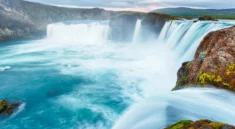
In the shifting sands and sunlit canyons of the Middle East, stories of resilience, wisdom, and ancient wanderings are written into the very landscape. This region—often perceived through the lens of history, conflict, and religious significance—also offers a deeper, more soulful narrative: one of nomadic traditions, age-old hospitality, and breathtaking beauty. Following ancient trails and learning from Bedouin wisdom in the heart of the Middle East is not just an exploration of land, but an inward journey through silence, humility, and cultural depth.
From the red dunes of Wadi Rum to the rock-carved city of Petra, from the tranquil oases of Oman to the mountain passes of Jordan and Saudi Arabia, these lands echo with footsteps of prophets, merchants, and nomads. To walk here is to follow paths forged millennia ago and to be guided by the oral histories, desert skills, and spiritual perspective of the Bedouin people.
The Desert: A Living Storybook Of Time
The Middle Eastern deserts are not voids—they are vibrant ecosystems filled with life, history, and spiritual presence. The Wadi Rum desert in southern Jordan, known as the “Valley of the Moon,” is a vast expanse of sandstone mountains, narrow canyons, and ancient petroglyphs. It’s where T.E. Lawrence once rode with the Arab Revolt, and it remains largely unchanged.
Here, silence speaks louder than words. As you trek across golden sands and sleep under a canopy of stars, the mind quiets, and time takes on a different rhythm. Days begin with the glow of sunrise over craggy peaks and end with the crackle of fire as Bedouins share tea brewed over hot coals.
The Bedouin, whose name means “desert dwellers,” are the soul of this place. Their traditions, passed down through generations, are rooted in adaptation to the harsh environment and deep respect for nature and community. To travel with a Bedouin guide is to walk not only across land, but through layers of meaning and myth.
Petra: Lost City Of Stone And Spirit
Few places embody the intersection of history, engineering, and mystery like Petra, the ancient Nabataean city carved into rose-red cliffs in southern Jordan. Often referred to as the “Lost City,” Petra was a thriving trade center over 2,000 years ago, connecting Arabia, Egypt, and the Mediterranean world.
Walking the Siq, a narrow canyon leading to the famous Treasury (Al-Khazneh), is a spiritual experience. The walls rise high, the sunlight flickers, and then suddenly, the monumental facade appears, revealing the ingenuity of its creators. Petra is not just about its iconic tombs and temples; it’s about the water channels, the amphitheaters, the humble homes tucked behind stone walls—evidence of a complex and adaptive society.
Today, local Bedouin tribes still inhabit parts of Petra, continuing to honor their ancestors’ connection to the land. Many of them act as storytellers, musicians, and guides—offering insight into both ancient and modern desert life.
Oman: Oases, Mountains, And Ancient Routes
While Jordan and Saudi Arabia draw the spotlight for their iconic sites, Oman offers a more tranquil but equally profound desert experience. Its Empty Quarter (Rub’ al Khali) is one of the largest sand deserts in the world, where dunes rise like waves and the silence feels sacred.
Oman is also home to spectacular wadis (seasonal riverbeds), date plantations, and ancient aflaj irrigation systems still in use today. The Hajar Mountains, with their terraced farms and cool breezes, provide a striking contrast to the desert heat.
Traveling through Oman’s hinterlands, you encounter frankincense trees, old caravan routes, and warm Omani hospitality. Here too, Bedouin values of generosity, humility, and storytelling are ever-present. You might be invited to drink strong, cardamom-laced coffee and eat dates while listening to poems recited in melodic Arabic.
The Bedouin Way: Hospitality, Wisdom, And Resilience
At the heart of this journey is the Bedouin culture—a system of values and practices shaped by the desert’s challenges. Despite the simplicity of their lives, Bedouins possess a wealth of ecological knowledge, oral history, and spiritual insight.
One of the most revered principles in Bedouin life is hospitality. A guest is seen as a divine gift, and hosts often serve the best of what they have. Whether you are a weary traveler or a stranger passing by, you will be welcomed with tea, food, and conversation.
Another principle is sabr, or patience. In a landscape where survival often depends on timing, water, and weather, patience is more than a virtue—it’s a way of life. Coupled with sharaf (honor) and karam (generosity), Bedouin ethics offer a timeless model for dignity, kindness, and coexistence.
Even their navigation techniques—reading stars, winds, and sand patterns—reveal a deep, symbiotic relationship with nature. Their poetry, often composed on the move, is both lyrical and philosophical, capturing the beauty and fragility of the human condition.
Spiritual Reflections: A Pilgrimage Beyond Borders
To follow ancient trails in the Middle East is to engage in a kind of spiritual pilgrimage. Whether you are religious or not, the landscapes themselves evoke a sense of the divine. This is the land of prophets and pilgrimages, of Mecca, Jerusalem, and countless sacred wells, mountains, and shrines.
Even secular travelers find themselves pausing in quiet contemplation. Watching a sunrise from a dune’s crest or walking through a mountain pass at dusk can feel like communion with something greater than oneself.
The desert teaches detachment—from materialism, from ego, from the need for control. In its vastness, you are small. And in that smallness, you find clarity.
Starry Skies And Campfire Stories
Nights in the desert are perhaps the most enchanting part of the journey. With no urban glow to obscure them, the stars shine with a brilliance that seems almost close enough to touch. Constellations emerge clearly, and the Milky Way forms a luminous path overhead.
Around a campfire, Bedouins will share folktales, wisdom from ancestors, and songs played on the rebab (a traditional bowed instrument) or oud (a pear-shaped stringed instrument). Stories of jinns, of love and loss, and of ancient warriors who crossed these same sands centuries ago bring the desert to life in new ways.
Modernity And Preservation
Today, Bedouin culture faces both opportunities and challenges. As modern life encroaches and younger generations migrate to cities, there is an ongoing effort to preserve traditional ways. Tourism, when done ethically, plays a role in this—providing income while also respecting and promoting local knowledge.
Eco-camps, Bedouin-run trekking companies, and cultural festivals are rising in popularity, giving travelers the chance to engage deeply and authentically with desert life. Governments and NGOs also support efforts to document oral histories, protect natural landscapes, and support sustainable tourism.
Travel Tips For Authentic Experiences
If you’re inspired to walk these ancient trails and learn from Bedouin wisdom, consider the following tips:
- Travel with local guides. Not only will you gain deeper insights, but you’ll also support the community.
- Respect local customs. Dress modestly, ask before photographing people, and observe etiquette.
- Stay in eco-lodges or Bedouin camps. These offer immersive experiences and limit your environmental footprint.
- Slow down. The desert isn’t a place to rush through. Let the pace of the land guide you.
- Engage in conversation. Bedouins are natural storytellers. Ask questions. Listen. Reflect.
Conclusion: Wisdom In The Winds
The heart of the Middle East is not just found in ancient ruins or religious texts—it is alive in the voices of Bedouins, in the curves of sand dunes, in the taste of desert tea, and in the silence between camel steps.
To follow ancient trails here is to walk toward understanding—of a region often misunderstood, of a people often romanticized but rarely truly known, and of oneself.
In a world that moves fast and speaks loud, the desert teaches stillness and simplicity. In a time of disconnection, the Bedouin way teaches hospitality, memory, and meaning. And in a time of abundance, the harsh beauty of the desert reminds us of what truly matters.
So come, follow the wind-worn paths of prophets and nomads. Sit by the fire beneath the stars. Share bread with strangers who feel like kin. In the vast, sunlit silence of the desert, you may just hear your truest self whisper back.




